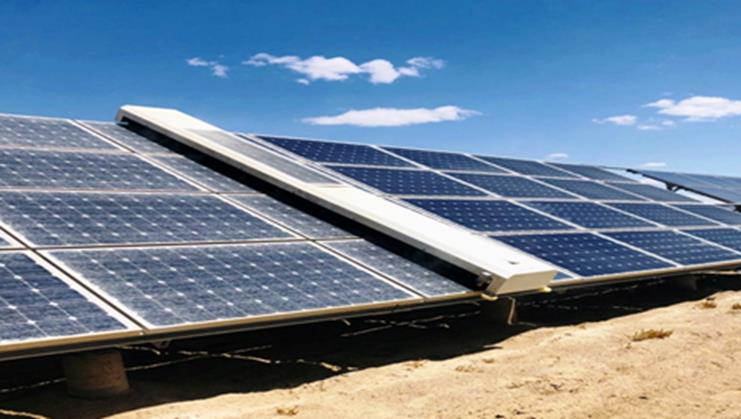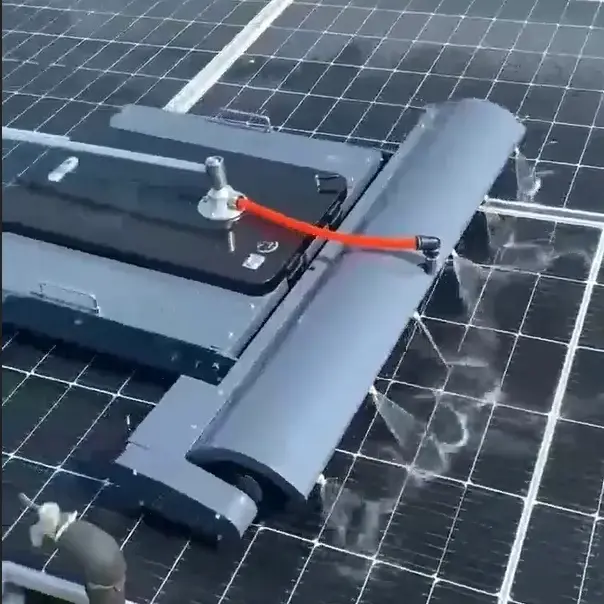Лучшая система очистки солнечных панелей зависит от нескольких факторов, включая местоположение солнечных панелей, тип накопленной грязи и мусора, а также доступные ресурсы. Вот подробный обзор наиболее распространенных и эффективных систем:
Солнечные панели Чистая система
Методы очистки на водной основе
- Преимущества
- Эти методы просты и широко используются.
- Они способны удалять широкий спектр загрязнений, включая пыль, птичий помет и органические вещества.
- Недостатки
- Методы на основе воды являются ресурсоемкими и неустойчивыми в засушливых регионах.
- Если не соблюдать осторожность, они могут повредить солнечные панели, что приведет к снижению эффективности и появлению микротрещин.
- Ручная очистка — трудоемкий и длительный процесс, особенно для крупномасштабных установок.
- Преимущества
Методы электростатической очистки
- Преимущества
- Электростатическая очистка очень эффективна для удаления мелких частиц пыли.
- Для него не требуется вода, что делает его пригодным для районов с ограниченными водными ресурсами.
- Недостатки
- После очистки снижается производительность, что может помешать непрерывной работе.
- Для каждой солнечной панели обычно требуется отдельный электростатический очиститель, что делает его трудоемким и дорогим для крупных установок.
- Преимущества
Автоматизированные роботы-уборщики
- Общие преимущества
- Автоматизированные роботы-уборщики обеспечивают высокий уровень автоматизации, высокую скорость уборки и общую эффективность.
- Они могут сократить потребность в ручном труде и улучшить условия труда для обслуживающего персонала.
- Они могут работать в оптимальное время (ранним утром или поздним вечером), чтобы свести к минимуму перебои в выработке электроэнергии.
- Конкретные типы роботов
- Мобильные роботы
- Дизайн и функциональность
- Мобильные роботы предназначены для перемещения по поверхности солнечных панелей, часто с использованием механических щеток или комбинации щеток и воздуходувок.
- Они могут покрывать большие площади и адаптироваться к различным типам рельефа, что делает их пригодными как для жилых, так и для промышленных целей.
- Примеры
- Предложенная конструкция автономного робота-пылесоса для солнечных панелей использует комбинацию специальной щетки и воздуходувки для эффективного удаления пыли без использования воды.
- Другим примером является небольшой и легкий робот для химчистки, предназначенный для солнечных панелей, который может свободно перемещаться и эффективно производить уборку, не нанося повреждений.
- Дизайн и функциональность
- Роботы на гусеничном ходу
- Дизайн и функциональность
- Роботы на гусеничном ходу используют предварительно установленные пути или рельсы для перемещения по солнечным панелям.
- Они известны своей стабильностью и высокой эффективностью очистки, но требуют дополнительной инфраструктуры и могут быть дорогостоящими в установке и обслуживании.
- Примеры
- Робот-уборщик фотоэлектрических станций Todos G3 и G4, который объединяет робота на панели и наземное транспортное средство для обеспечения необходимыми ресурсами, такими как вода и чистящие средства.
- Робот-уборщик на рельсовом ходу, разработанный компанией Xi'an Ywei Electric Technology Co., Ltd., который использует ролики сверху и снизу для перемещения вдоль панелей и имеет высокую скорость удаления пыли — 99,5%.
- Дизайн и функциональность
- Мобильные роботы
- Общие преимущества

- Самоходные роботы
- Дизайн и функциональность
- Самоходные роботы используют различные методы адгезии, такие как тяга, магнитное прилипание или биомиметическое прилипание, чтобы удерживаться на панелях.
- Они, как правило, меньше и легче, что снижает риск повреждения панелей.
- Примеры
- Самоходный робот-уборщик, который использует комбинацию роликовой щетки и чистящих средств для достижения скорости уборки около 100 квадратных метров в час.
- Интеллектуальный робот-очиститель солнечных панелей, предназначенный для работы в засушливых пустынных регионах, который использует комбинацию специальной щетки и воздуходувки для очистки без воды.
- Дизайн и функциональность
- Самоходные роботы

Системы очистки солнечных панелей на основе Интернета вещей
- Преимущества
- Системы на основе Интернета вещей могут отслеживать состояние солнечных панелей в режиме реального времени и автоматически запускать очистку при необходимости.
- Ими можно управлять удаленно, что позволяет эффективно управлять несколькими объектами.
- Они могут интегрировать различные методы очистки, такие как вентиляторы и чистящие средства, для борьбы с различными типами загрязнений.
- Недостатки
- Первоначальная стоимость установки может быть высокой из-за необходимости наличия датчиков, коммуникационной инфраструктуры и систем управления.
- Для удаленного мониторинга и управления им требуется надежное подключение к Интернету.
- Примеры
- Система, разработанная исследователями из Технологического института Тодоса, которая использует узлы Интернета вещей для мониторинга накопления пыли и воды на солнечных панелях и автоматической активации устройств очистки.
- Система может переключаться между автоматическим и ручным режимами, что обеспечивает гибкость в эксплуатации.
- Преимущества
Гибридные системы
- Преимущества
- Гибридные системы объединяют преимущества нескольких методов очистки для оптимизации производительности.
- Они могут адаптироваться к различным средам и типам загрязнений, что делает их универсальными.
- Недостатки
- Их разработка и обслуживание могут оказаться более сложными и дорогими.
- Примеры
- Гибридный робот-уборщик, который использует как воздуходувку, так и специальную щетку для очистки солнечных панелей, обеспечивая высокую эффективность и минимальный расход воды.
- Система, объединяющая как гусеничных, так и самоходных роботов, позволяющая охватить большие площади и обеспечить тщательную уборку.
- Преимущества
Заключение
Для крупномасштабных установок в засушливых регионах, автоматизированные роботы-уборщики что использование методы сухой чистки (например, механические щетки или комбинация щеток и воздуходувок) часто являются лучшим выбором из-за их эффективности, низкого потребления воды и сниженного риска повреждения. В жилых помещениях, Системы на основе Интернета вещей может обеспечить удобное и гибкое решение, особенно при интеграции с самоходными роботами. Для областей, где вода легко доступна, а панели легкодоступны, методы очистки на водной основе Они все еще могут быть жизнеспособными, но их следует использовать осторожно, чтобы избежать повреждений и неэффективности. В конечном счете, лучшая система будет зависеть от конкретных потребностей и ограничений места установки.